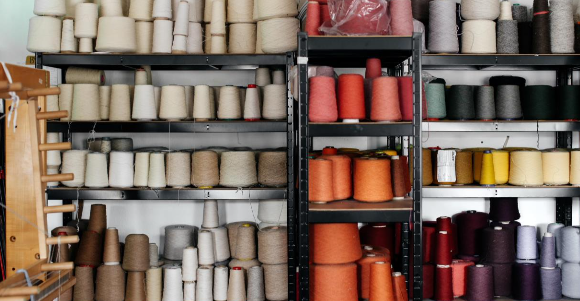Juliet Bailey, Bristol Weaving Mill:
When we established The Bristol Weaving Mill in 2013, our goal was to take control of our own design and production in a way that would allow us to be innovative with design, but also to gain more control over our environmental impact. The Bristol Weaving Mill is set up as a micro-mill in the heart of Bristol, where we can design, sample, prototype and manufacture fabrics and products with full control of the supply chain. We will always need to partner with other facilities around the UK for things like bulk production, yarn sourcing or finishing, but our goal is to design in a sustainably conscious way, and bringing our warping in-house was a big part of this vision.
There were a number of hurdles to overcome to get to the end-goal, the first being the space available to us, the second being budget, the third expertise and the fourth the pandemic. However, we knew that bringing this process in-house would have a significantly positive impact on our carbon footprint, as well as being a cost-saving measure in the long-term. Prior to this, we had to send our warp beams to Yorkshire or Scotland for warping, a costly process in both senses.
Warping mills and creels for sectional warping are very large and require a lot of space, and they will usually service a fleet of weaving looms whereas we only have the one industrial loom in Bristol. Modern single-end warpers are more compact in terms of floor space; however, they often require great height and are very expensive. Through research, we understood that a historic warper would better suit our needs and budget, but the issue of floor space for creels was a problem. Finally, we spotted a 100+ year old Hattersley warper on the second-hand textile machinery market that had a wall-mounted creel, ideal for our budget, space and needs and so we jumped at the opportunity.
Just as the warper arrived, our business was hit by the impact of Covid and unfortunately this put the project on hold and the warper remained un-used for several years. The Mill is now recovering from this period, but as with many other small businesses the impact will be a long lasting one, and paired with the cost of living crisis, rises in materials and energy costs, and Brexit, this has left us with a considerably different landscape, market and budgets to pre-Covid times. It was only when Emma at The South West England Fibreshed suggested we access the bursary fund that it became a possibility to get the warper going again, and we match-funded the project to get it off the ground.
The final hurdle of expertise was then the only barrier, as the machinery is so rare and old, and Hattersley went out of business in the 1980’s. There are only a handful of people in the UK who know anything about maintaining and operating these kinds of warping mills. Through an Instagram advert we were lucky enough to find Timothy Jenkins, a relatively local ex-warper (previously at Gainsborough Silk Mill), Hattersley warping mill enthusiast and Chemist by trade. After a few conversations Timothy agreed to visit us for a week to service the warper, write a condition report and training manual, and spend time training Rheanna in how to operate the machine.
Now the warper is up and running, it’s really transformed our day-to-day operations and given us more control over our process and impact. There is still a fair amount of work that needs to be done to the machine before it’s in top condition, but it’s wonderful to see the old machinery running again.
Rheanna Davison:
I was delighted to be trained to use the Sectional Warper at Bristol Weaving Mill. The mill had secured a bursary from South West Fibreshed to fund the training. The warper had been acquired by BWM a couple of years prior and I was excited to be a part of getting it up and going!
Tim Jenkins was extremely knowledgeable and clear in his teaching. He led me through understanding the process of sectional warping, going through step by step as well as giving me a thorough run down of the machine itself.
The training consisted of a 3-day introduction to the machine. In doing so I learned about how the machine operated, how to look after and maintain the machinery including all of its quirks! After completing this training, I have a solid understanding of day-to-day operation, as well as problem solving, and working to differing and varied warp specifications.
This training has played a vital role in sustaining a segment of the UK’s textile industry by passing down essential skills. Since completing the training, I’ve created several warps, and I feel that I’m making some progress while contributing to the preservation of the UK’s weaving heritage.

To provide the best experience we use cookies to store and/or access information. Consenting will allow us to process data on this site. Not consenting may adversely affect certain features and functions.
Sign up here to receive SERGE: Growing our fibre to fashion community, a newsletter we co-write with Bristol Textile Quarter.